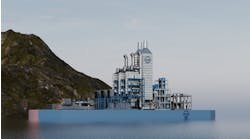Offshore staff
STAVANGER, Norway -Emerson Process Management has launched the latest version of its reservoir modeling software, Roxar RMS. The new version - RMS 2013.1 - comes with enhanced structural modeling tools that acknowledge realistic uncertainties in the data and improve volumetric sensitivities. This makes it faster and easier for geo-modelers to build geological scenarios, investigate the full effects of structural uncertainty, and maximize the value of their reservoir assets.
“Too often in the past reservoir modelers have had to resign themselves to using best case estimates of faults and horizons, with the inherent uncertainty in these interpretations often neglected and thereby underestimating the actual uncertainty in reservoir volumes,” said Kjetil Fagervik, managing director of Emerson’s Roxar Software Solutions.He continues: “With our new version of Roxar RMS and our tightly integrated structural modeling and gridding tools, users will be able to quantify uncertainty more effectively and increase confidence when it comes to crucial decisions on where to drill, what production strategies to adopt, and how to maximize recovery.”
As part of the new enhancements, RMS 2013.1 also sees fault uncertainty tools further integrated with structural modeling and 3D gridding. This enables users to build fault uncertainty models in full and investigate a wide variety of scenarios corresponding to the uncertainty in the input data. In addition, horizon uncertainty modeling is significantly enhanced, allowing users to create horizons and zones based on uncertainty data and information derived from well picks, velocities, seismic travel times and isochores. Uncertainty modeling has also been extended with new parameters added such as the modeling of fault sealing effects and fractures.
Reservoir management decision-making is also improved with RMS 2013.1 through improved well targeting and a new Adjust to Wellsjob that supports the calculation of residuals between the grid and well picks and can adjust the grid to exactly match the well picks. Other features include an integrated isochore modeling tool that provides users with full quality control over isochore input data and a predictive analytics tool for identifying sweet spots within unconventional fields.
The focus on the geophysical domain sees further enhancements to the new model-driven interpretation (MDI) tools first released in RMS 2013 with improvements to MDI and velocity modeling through new tools for QC-ing the velocity model, providing input for horizon uncertainty modeling, and for well-ties. Finally, Roxar RMS 2013.1 comes with improved workflow efficiencies and performance through multi-threading (the ability for computing to take place in parallel), SEG-Y importing and RMS Data Explorer that allows users to manipulate large amounts of data with advances in well administration and fault grouping/sorting.
Kjetil Fagervik concludes:“When it comes to strengthening operator confidence in their reservoirs’ economics, improving decision-making and increasing workflow productivities and efficiencies, Roxar RMS is changing the reservoir modeling landscape. RMS 2013.1 will be the first of a number of significant modeling advances over the coming months.”
Emerson’s flagship reservoir modeling solution, Roxar RMS, is comprised of 24 fully integrated software modules that form a seamless and fully integrated seismic to simulation workflow. This includes seismic interpretation, structural model building, 3D gridding, facies and petrophysical modeling, flow simulation, well planning and uncertainty modeling tools. RMS operates on Red Hat Enterprise Linux 64-bit versions 5 and 6 and on Windows 64-bit Vista and 7.
06/16/2015



